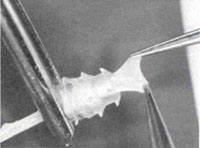Trick up the sleeve
Trick up the sleeve

GERMAN scientists have devised a method to repair blood vessels damaged during delicate surgery by coupling them using a novel biodegradable device.
Anastomosis, or coupling of thin blood vessels with sutures, is usually an intricate task which requires a great deal of surgical time and skill. Although several mechanical devices are being developed to simplify anastomosis, doctors are still at a loss to find one effective in coupling 2 blood vessels differing markedly in their diameters.
But a team of scientists at the University Hospital of Freiburg, Germany, led by W Bahr solved the problem by using a cuff and a sleeve made of a biodegradable material called "polylactide". This material has some interesting properties, said Bahr at the International Cancer Congress recently held in New Delhi -- the sleeve, for instance, expands along its diameter when heated above 59o C and the attained expansion can be maintained by cooling below 59o C. However, it can be reverted to its original diameter by reheating to above 59o C -- a unique characteristic of polylactide, known as the "memory effect".
To carry out anastomosis, the scientists pull the vessel of small diameter through the cuff and turn it inside out. The vessel with the larger diameter is slipped over the everted smaller vessel and the shrinkable sleeve is then moved over both vessel ends and the cuff. The sleeve is made to shrink by heating it to above 59o C, forcing the vessel against the everted vessel and its cuff.
The scientists tested the new device to couple rabbit blood vessels of diameters in the range of 1-4 mm with those with a diameter of 1-2 mm greater. Bahr claims that the time needed for each anastomosis using the new method was less than 5 minutes, and that the joint set after one hour. After a year, the biodegradable polylactide material vanished from the body. The scientists have plans to transfer this technology to industry in Germany soon.







